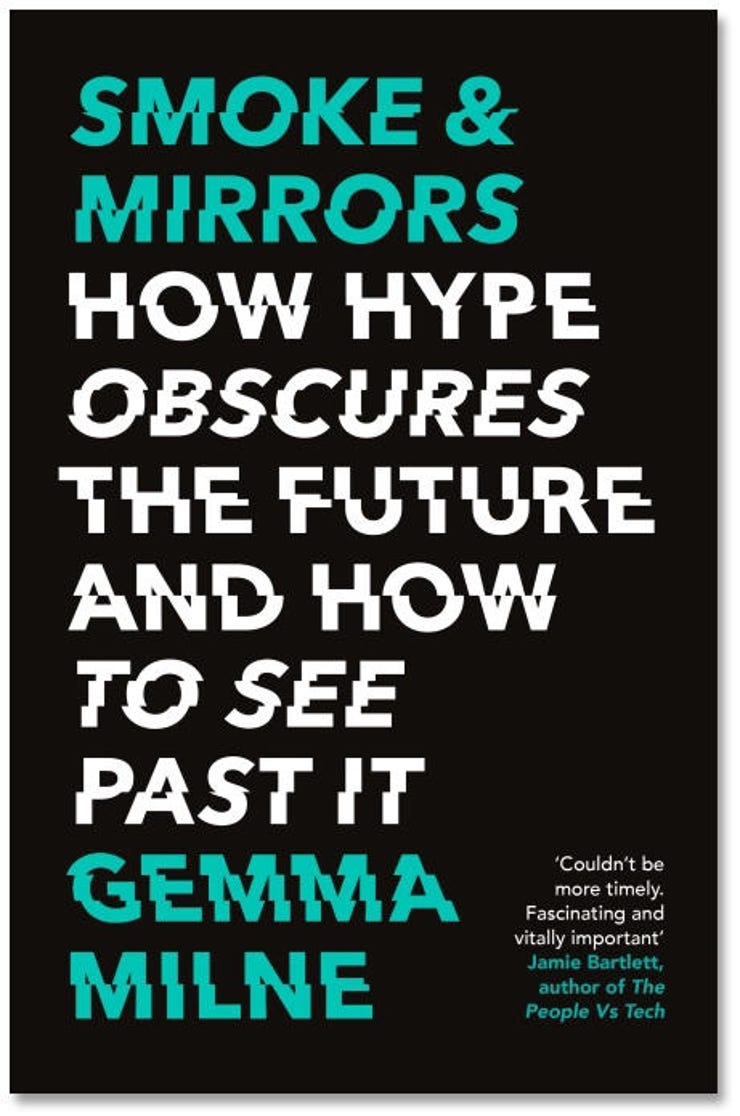Smoke & Mirrors, book review: How to identify and filter out technology hype


Smoke & Mirrors: How Hype Obscures the Future and How To See Past It • By Gemma Milne • Little, Brown Book Group • 322 pages • ISBN 978-1-4721-4366-2 • £14.99
There was a story that made the rounds in the middle of the dot-com bust. As share prices of tech companies -- both good and bad -- cratered, someone asked a bunch of Silicon Valley types these two questions: Was the internet hyped? (Yes). How many thought that in five years the internet would be bigger than it was then? (Everyone).
Even at the time, if you were spending any time online you knew that the internet wasn't hyped -- but many internet businesses were. The worst were so taken in by their own hype that they recklessly squandered resources that, husbanded carefully, might have helped them survive.
In her new book, Smoke & Mirrors: How Hype Obscures the Future and How To See Past It, the technology writer Gemma Milne might call the 1990s hype around the internet 'fair hype' -- that is, hype that reflects the reality of a growing technology beginning to permeate the world. Hype, she writes, is neutral: we must learn to see past it to judge whether it's fair or problematic.
The distinction is not always easy to make. Even the best technological and scientific advances have to find the right implementation, management and timing in order to succeed. The failure of the business promoting it may mean nothing in the long run, while a company trying to make a go of a hot-air technology may yet find a way to pivot to something that brings it success. It's much rarer to get a situation where both the company and the technology are hot air, but fly high on hype; I'm thinking of Theranos, which bamboozled some famously smart people for a while and whose former CEO is now awaiting trial.
Hype, from vertical farming to ET
In Smoke & Mirrors, Milne is interested in technology hype, not business hype, and divides her subjects into three frames: 'Now', which looks at the current impact of hype on our world; 'Next', which discusses how hype is affecting development in various fields; and 'Nearing', which discusses how hype halts critical thinking and damages future progress. To illustrate her points, she looks at nine different technologies: vertical farming; cancer cures; batteries; nuclear fusion; commercial space travel; quantum computing; brain-computer interfaces; algorithmic decision making; and extraterrestrial life.
SEE: Managing AI and ML in the enterprise 2020: Tech leaders increase project development and implementation (TechRepublic Premium)
In the process, she points out many places where apparent novelty distracts us from seeing the same old familiar real-life issues. In the case of AI, for example, she raises the trolley problem, a philosopher's thought experiment that people discuss with respect to programming self-driving cars as if it were an entirely new issue. And yet, Milne points out, we fail to recognise the many areas of daily life where we already face exactly these decisions -- healthcare resources, for example.
The ability to identify hype when it appears is, Milne argues, an essential part of recognising misinformation. We're not stupid, and we don't need to be fooled in order to adopt new technologies. But if we keep falling for hype, inventors and hypesters will keep spinning wild stories at us. We should respond by asking questions such as 'Is this cool, new technology worth its cost?' Well, is it?
RECENT AND RELATED CONTENT
Has container hype jumped the shark?
For self-driving cars, winter is coming
5G marketing echoes the hype around 3G and 4G: ICANN CTO
Blockchain and business: Looking beyond the hype
AI for business: What's going wrong, and how to get it right
Read more book reviews
- Startup Myths and Models, book review: A quirky guide to Startup Land
- Righting Software, book review: Building blocks for software architects
- Adventures of a Computational Explorer, book review: Wolfram's world, in 25 essays
- Home Computers: 100 Icons that Defined a Digital Generation, book review
- The Costs of Connection, book review: A wider view of surveillance capitalism